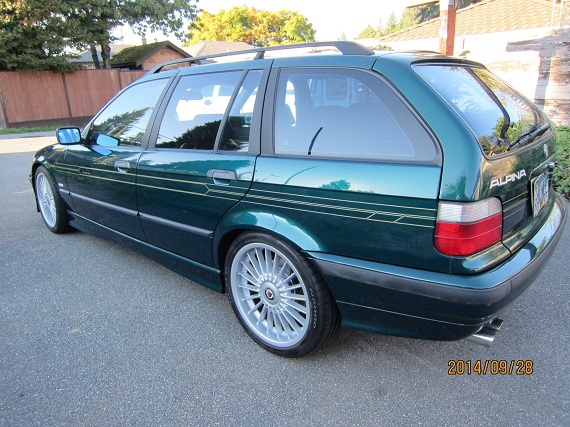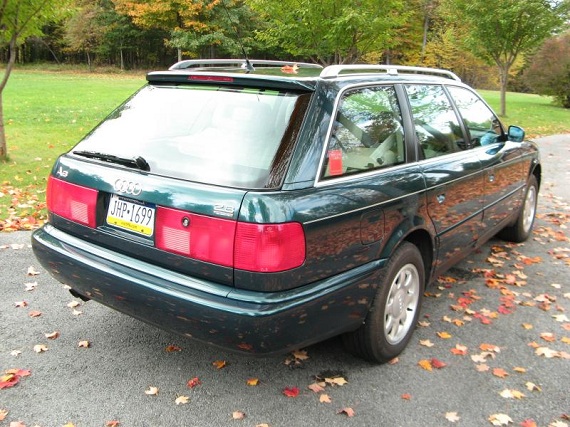While some other aftermarket tuners such as Ruf and Renntech offer turned up versions of the already potent cars, Alpina operates slightly differently – filling in the voids of models not offered by the manufacturer. There are plenty of examples of this, and if often seems to be misunderstood; Jeremy Clarkson’s review of the Alpina Roadster is probably the most notable case. A slower, softer, automatic version of the hardcore roadster certainly doesn’t make a lot of sense at first glance. But what Alpina does is give enthusiasts the opportunity to enjoy the performance that BMW offered in a slightly different package that sometimes outperforms the original platform car – Chris Harris recently found the B3 Biturbo to be nearly “the perfect car“. One of the notable missing gaps in the BMW lineup was a faster version of the E36 Touring; building off the earlier B6 – effectively, Alpina’s 4-door M3 challenger built between 1992 and 1993 with a bespoke engine and typical Alpina upgrades, the company later launched the Japanese-only market B6 2.8 Touring. Produced between 1996 and 1998, only 136 of these small wagons were produced, again utilizing the 240 horsepower bespoke Alpina motor, special wheels and interiors, Alpina’s own body kit, exhaust and suspension. They were available in 3 colors only; red, silver, and green:
Tag: 2.8
For a long time, enthusiasts have claimed that you need to have rear wheel drive to enjoy a car’s dynamic abilities or have a successful race car. However, while limited in their application, front-drivers have a very long and successful track record dating back to the 1960s. Let’s not forget the Mini, SAABs and even some early Audi rally efforts which used front-drive platforms and were winners. In touring cars, Audi ran Coupe GTs and front-drive 4000s in Group 5 and later Volkswagen took the idea of the performance hatchback to their Golf platform in the GTi. Wildly popular as a budget racer since new, the Golf’s basic layout and platform evolved into the Volkswagen coupes – both Scirocco and later Corrado. While the early Sciroccos also gained much success in SCCA racing in the 1970s and early 1980s, the Corrado introduced a new level of performance with the VR6 engine. While the torque-laden application would seem on the surface to be a bad match for a front driver, the Corrado when properly set up is truly an impressive car and massively quick – a great alternative to the E36 chassis, for example:
CLICK FOR DETAILS: 1992 Volkswagen Corrado SLC VR6 on eBay
5 CommentsLast fall we featured a 1995 Audi A6 that was in great shape for a low price. Life changed a bit for the seller and after a few weeks on the market he pulled the advertisement and drove the car for the past year. The seller is once again ready to part ways; there are a few additional miles that were accrued but the seller has adjusted the price accordingly and also performed a complete timing belt service. If you’d like a lot of style, class and a smooth performer in any condition capable of carrying a massive load, this A6 looks the part and is ready for the next owner. It’s hard to get a much nicer, more capable car for less money.
CLICK FOR DETAILS: 1995 Audi A6 2.8 quattro Avant on eBay
The below post originally appeared on our site November 13, 2013:
3 CommentsThe Audi B5 was really the first Audi chassis that gained mass appeal for modifications. Sure, the Quattro, 5000, 200, S4 and S6 all had crowds that followed them and modified them, but it was really the B5 that took the Audi tuning theme to the masses. Most of those masses focused on two models; if you were new to the brand you bought and modified the plentiful and relatively cheap 1.8T, and if you could swing the hefty payments you bought the twin-turbocharged S4. Both accepted increased levels of boost easily, making them a no brainer for the tuning crowd. But quickly forgotten in the mix was the silky-smooth 2.8 V6. Initially available in 12 valve form, in 1998 Audi upgraded to the 30V heads. For the first time, the Audi V6 produced power levels near its competition, and the smooth and responsive V6 was a nice match for the slick look of the A4. But easy to tune it wasn’t; you weren’t left with many options outside of exhaust and intake if you wanted to turn the wick up on your 2.8. Unless, of course, you turned to unnatural forms of aspiration – happily supplied by PES in the form of a supercharger:
CLICK FOR DETAILS: 2001 Audi A4 quattro on eBay
1 CommentGrowing up, my parents had an affinity for Hondas. I think years of Fiats wore my father down and the reliability of Japanese subcompacts was too attractive. But then, in the late 1990s, Volkswagen changed the mid-sized sedan game with the B5 Passat. Sharing architecture with the Audi A4, the new Passat brought a lot of luxury and refinement to what was becoming an otherwise lackluster vehicle segment in the US. Sure enough, my parents traded their 1997 Honda Accord EX for a 1999 Passat GLS V6 with a 5-speed manual gearbox. It took a while to have the car delivered, since the manual gearbox was a bit of an oddball request, but once they got the car, it was leaps and bounds more engaging than the four cylinder Accord ever was. My parents kept the car for about three years before trading it for a 2000 Mercedes-Benz C280 (which they still have), but I was a big fan of that Passat.
This silver on black leather 2004 Passat for sale in Pennsylvania is the later B5.5 generation, but has the same color and drivetrain combination as the Passat that was in our family, one that I have fond memories of. It was one of those cars that should have stuck around in the garage a bit longer.




